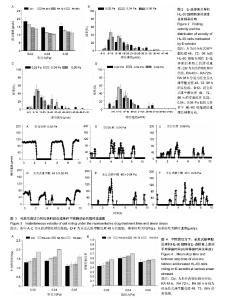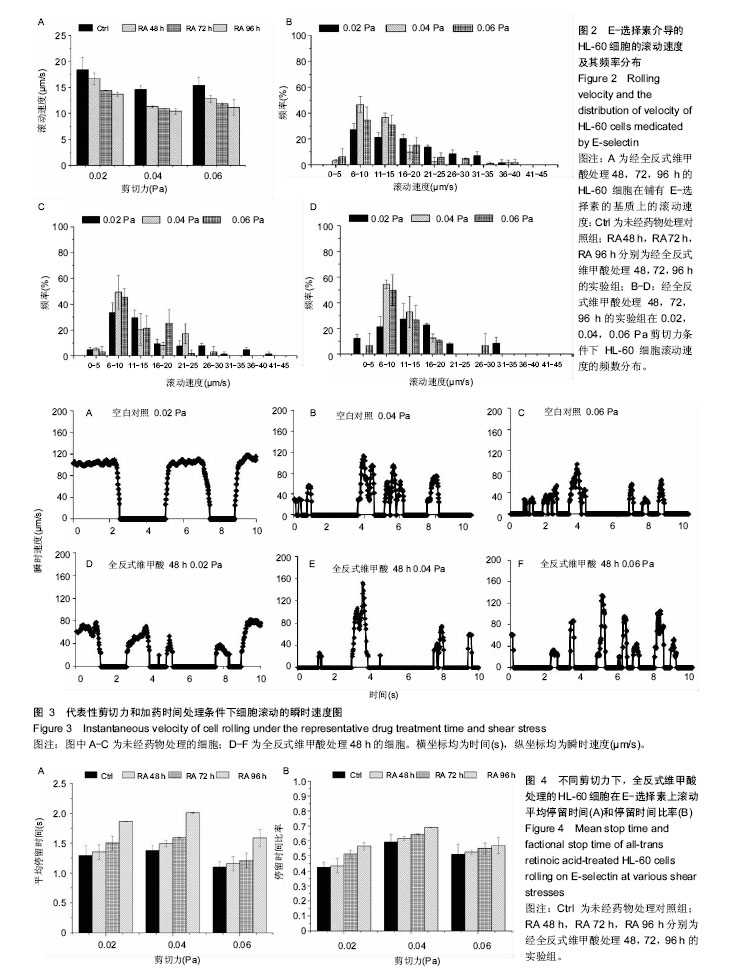Chinese Journal of Tissue Engineering Research ›› 2018, Vol. 22 ›› Issue (13): 2120-2125.doi: 10.3969/j.issn.2095-4344.0499
Previous Articles Next Articles
Rolling adhesion of HL-60 cells treated with all-trans retinoic acid on E-selectin
Xiao Jing, Li Qu-huan, Yang Bi-shan, Fang Ying, Wu Jian-hua
- School of Bioscience and Engineering, South China University of Technology, Guangzhou 510006, Guangdong Province, China
-
Revised:2017-12-18Online:2018-05-08Published:2018-05-08 -
Contact:Wu Jian-hua, Ph.D., Professor, School of Bioscience and Engineering, South China University of Technology, Guangzhou 510006, Guangdong Province, China; Li Qu-huan, Ph.D., Associate professor, School of Bioscience and Engineering, South China University of Technology, Guangzhou 510006, Guangdong Province, China -
About author:Xiao Jing, Master candidate, School of Bioscience and Engineering, South China University of Technology, Guangzhou 510006, Guangdong Province, China -
Supported by:the National Natural Science Foundation of China, No. 31170887, 11432006, 11272125, 31200705; the Fundamental Research Funds for the Central Universities, No. 2017MS098, 2017MS106
CLC Number:
Cite this article
Xiao Jing, Li Qu-huan, Yang Bi-shan, Fang Ying, Wu Jian-hua. Rolling adhesion of HL-60 cells treated with all-trans retinoic acid on E-selectin[J]. Chinese Journal of Tissue Engineering Research, 2018, 22(13): 2120-2125.
share this article

2.1 特异性实验 为了确保HL-60细胞在E-选择素铺展的底板上黏附是由特异的受体/配体相互作用所介导,开展了特异性实验,包括E-选择素实验组,HBSS空白对照组和2%BSA实验对照组。设定壁面剪切力为0.02,0.04,0.06 Pa,驱动0.5×109 L-1 HL-60细胞悬浮液在基质上滚动,设定视窗观测细胞的黏附行为,统计1 min后黏附在基质上的细胞数目。结果表明(图1),HL-60细胞在空白对照组底板仅有少数细胞(1,2个细胞)黏附现象,这可能是因为静电作用等非特异性黏附所介导。实验对照组细胞黏附数目极少,甚至为零,这证明了底板通过2%BSA封闭后,对非特异性黏附具有明显的阻断效应。实验组的底板铺有40 μg/L E-选择素,同时被2%BSA包被孵育2 h,细胞黏附数目(10-20个细胞)较多。通过对不同剪切力不同底板平行3组实验数据进行方差分析(给定显著性水平为α=0.01),实验组和对照组差异显著,表明HL-60细胞滚动黏附是由E-选择素与PSGL-1单分子对特异性相互作用介导的,并且2%BSA能有效阻断细胞底板间非特异性黏附,同时对PSGL-1单分子对特异性相互作用介导的HL-60细胞滚动黏附现象没有影响。"


2.2 滚动速度 设置剪切力0.02,0.04,0.06 Pa条件下,经ATRA处理48,72,96 h的HL-60细胞在铺有E-选择素的基质上滚动,观察细胞滚动黏附行为,测定其滚动的平均速度,实验结果见图2。从图可以看出,随着剪切力从0.02 Pa到0.04 Pa的增加,各组细胞滚动速度呈现降低趋势,随着剪切力从0.04 Pa至0.06 Pa的进一步增加,各组细胞滚动速度呈现增加趋势,即随剪切力的单调增加,平均速度曲线呈现先减少后增加的双态性趋势(图2A)。相应地,滚动速度的频率分布亦随剪切力的增加,低滚动速度的细胞所占的比率表现出先多后少的趋势(图2B-D)。而在同一剪切力下,随着药物处理时间的延长,细胞的滚动速度呈现出下降趋势,原因可能在于药物处理使得细胞的黏附性增强。 2.3 瞬时速度 为了探索调控平均滚动速度双态性的机制,跟踪每一剪切力和药物处理下的细胞滚动,作出瞬时滚动速度对时间的图形。选择不同剪切力下未经药物处理和药物处理48 h有代表性的细胞各1个作出瞬时滚动速度图。从图3可知,未经药物处理和药物处理的细胞在较低剪切力下,细胞的滚动快速无序,随着剪切力提高至阈值,细胞滚动速度减小而变得逐渐有序,超过阈值之后,随着剪切应力的进一步提高,细胞滚动再次加速并变得无序。平均停留时间表现出规律性先增大后减少的趋势。 2.4 停留时间和停留时间比率 为了定量图3所示的滚动行为,进一步使用细胞滚动的二步模型,自编Excel宏,统计细胞的停留时间和停留时间比率,见图4。由图可知,随剪切力的增大,细胞停留时间和停留时间比率亦呈现先增大后减少的趋势,与细胞滚动速度先减少后增大(图3)的趋势互补,这可能说明,滚动速度的减少是由于平均停留时间的增大所致。同样,在相同剪切力条件下,随着药物处理时间的增加,平均停留时间逐渐增大。与随药物处理时间增长平均滚动速度减低的趋势相反,这进一步证明,平均滚动速度和平均停留时间成负相关关系。"

| [1] Chen L, Cui YB, Si YL, et al. Lentivirus?mediated RIG?I knockdown relieves cell proliferation inhibition, cell cycle arrest and apoptosis in ATRA?induced NB4 cells via the AKT?FOXO3A signaling pathway in vitro. Mol Med Rep. 2017;16(3): 2556-2562.[2] Ma RJ, Zhu ZM, Yuan XL, et al. Efficacy of combination of ATRA, ATO and anthracyclines induction therapy in patients with acute promyelocytic leukemia. Zhonghua Xue Ye Xue Za Zhi. 2017;38(6):523-527.[3] Emi N. Current treatment strategies for newly diagnosed and relapsed APL. Rinsho Ketsueki. 2017;58(10):1872-1877.[4] Humbert M, Federzoni EA, Tschan MP. Distinct TP73-DAPK2-ATG5 pathway involvement in ATO-mediated cell death versus ATRA-mediated autophagy responses in APL. J Leukoc Biol. 2017;102(6):1357-1370.[5] Herter J, Zarbock A. Integrin Regulation during Leukocyte Recruitment. J Immunol. 2013;190(9):4451-4457.[6] Zarbock A, Kempf T, Wollert KC, et al. Leukocyte integrin activation and deactivation: novel mechanisms of balancing inflammation. J Mol Med (Berl). 2012;90(4):353-359.[7] Hanna S, Etzioni A. Leukocyte adhesion deficiencies. Ann N Y Acad Sci. 2012;1250:50-55.[8] Begandt D, Thome S, Sperandio M, et al. How neutrophils resist shear stress at blood vessel walls: molecular mechanisms, subcellular structures, and cell-cell interactions. J Leukoc Biol. 2017;102(3):699-709.[9] Angiari S. Selectin-mediated leukocyte trafficking during the development of autoimmune disease. Autoimmun Rev. 2015;14(11):984-995.[10] McEver RP. Selectins: initiators of leucocyte adhesion and signalling at the vascular wall. Cardiovasc Res. 2015;107(3): 331-339.[11] McEver RP, Zhu C. Rolling cell adhesion. Annu Rev Cell Dev Biol. 2010;26:363-396.[12] Zarbock A, Ley K, McEver RP, et al. Leukocyte ligands for endothelial selectins: specialized glycoconjugates that mediate rolling and signaling under flow. Blood. 2011; 118(26):6743-6751.[13] Hofmann A, Gerrits B, Schmidt A, et al. Proteomic cell surface phenotyping of differentiating acute myeloid leukemia cells. Blood. 2010;116(13):e26-34.[14] Davis C, Fischer J, Ley K, et al. The role of inflammation in vascular injury and repair. J Thromb Haemost. 2003;1(8): 1699-1709.[15] Ley K. The role of selectins in inflammation and disease. Trends Mol Med. 2003;9(6):263-268.[16] Braess J. Acute myeloid Leukemia. Dtsch Med Wochenschr. 2016;141(24):1748-1751.[17] Lo-Coco F, Cicconi L, Breccia M. Current standard treatment of adult acute promyelocytic leukaemia. Br J Haematol. 2016; 172(6):841-854.[18] Nitto T, Sawaki K. Molecular mechanisms of the antileukemia activities of retinoid and arsenic. J Pharmacol Sci. 2014; 126(3):179-185.[19] Jeanne M, Lallemand-Breitenbach V, Ferhi O, et al. PML/RARA oxidation and arsenic binding initiate the antileukemia response of As2O3. Cancer Cell. 2010;18(1): 88-98.[20] Yago T, Wu J, Wey CD, et al. Catch bonds govern adhesion through L-selectin at threshold shear. J Cell Biol. 2004; 166(6):913-923.[21] Lawrence MB, Kansas GS, Kunkel EJ, et al. Threshold levels of fluid shear promote leukocyte adhesion through selectins (CD62L,P,E). J Cell Biol. 1997;136(3):717-727.[22] Finger EB, Puri KD, Alon R, et al. Adhesion through L-selectin requires a threshold hydrodynamic shear. Nature. 1996;379 (6562):266-269.[23] Yakovenko O, Sharma S, Forero M, et al. FimH forms catch bonds that are enhanced by mechanical force due to allosteric regulation. J Biol Chem. 2008;283(17): 11596-11605.[24] Evans E, Leung A, Hammer D, et al. Chemically distinct transition states govern rapid dissociation of single L-selectin bonds under force. Proc Natl Acad Sci U S A. 2001;98(7): 3784-3789.[25] Marshall BT, Long M, Piper JW, et al. Direct observation of catch bonds involving cell-adhesion molecules. Nature. 2003;423(6936):190-193.[26] Yago T, Zarnitsyna VI, Klopocki AG, et al. Transport governs flow-enhanced cell tethering through L-selectin at threshold shear. Biophys J. 2007;92(1):330-342.[27] Li Q, Wayman A, Lin J, et al. Flow-Enhanced Stability of Rolling Adhesion through E-Selectin. Biophys J. 2016;111(4): 686-699.[28] Li Q, Fang Y, Ding X, et al. Force-dependent bond dissociation govern rolling of HL-60 cells through E-selectin. Exp Cell Res. 2012;318(14):1649-1658.[29] Yago T, Wu J, Wey CD, et al. Catch bonds govern adhesion through L-selectin at threshold shear. J Cell Biol. 2004;166(6): 913-923.[30] Flynn PJ, Miller WJ, Weisdorf DJ, et al. Retinoic acid treatment of acute promyelocytic leukemia: in vitro and in vivo observations. Blood. 1983;62(6):1211-1217.[31] Huang AC, Hu L, Kauffman SA, et al. Using cell fate attractors to uncover transcriptional regulation of HL60 neutrophil differentiation. BMC Syst Biol. 2009;3:20.[32] Martin SJ, Bradley JG, Cotter TG. HL-60 cells induced to differentiate towards neutrophils subsequently die via apoptosis. Clin Exp Immunol. 1990;79(3):448-453.[33] Nowak D, Stewart D, Koeffler HP. Differentiation therapy of leukemia: 3 decades of development. Blood. 2009;113(16): 3655-3665.[34] Brown DC, Tsuji H, Larson RS. All-trans retinoic acid regulates adhesion mechanism and transmigration of the acute promyelocytic leukaemia cell line NB-4 under physiologic flow. Br J Haematol. 1999;107(1):86-98.[35] Lou J, Yago T, Klopocki AG, et al. Flow-enhanced adhesion regulated by a selectin interdomain hinge. J Cell Biol. 2006; 174(7):1107-1117.[36] Gee DJ, Wright LK, Zimmermann J, et al. Dimethylsulfoxide exposure modulates HL-60 cell rolling interactions. Biosci Rep. 2012;32(4):375-382.[37] Lei X, Lawrence MB, Dong C. Influence of cell deformation on leukocyte rolling adhesion in shear flow. J Biomech Eng. 1999; 121(6):636-643.[38] 彭时平. 全反式维甲酸处理下HL-60细胞增殖、分化及滚动黏附的研究[D].广州:华南理工大学, 2014:78. |
| [1] | Zhang Tongtong, Wang Zhonghua, Wen Jie, Song Yuxin, Liu Lin. Application of three-dimensional printing model in surgical resection and reconstruction of cervical tumor [J]. Chinese Journal of Tissue Engineering Research, 2021, 25(9): 1335-1339. |
| [2] | Zeng Yanhua, Hao Yanlei. In vitro culture and purification of Schwann cells: a systematic review [J]. Chinese Journal of Tissue Engineering Research, 2021, 25(7): 1135-1141. |
| [3] | Xu Dongzi, Zhang Ting, Ouyang Zhaolian. The global competitive situation of cardiac tissue engineering based on patent analysis [J]. Chinese Journal of Tissue Engineering Research, 2021, 25(5): 807-812. |
| [4] | Wu Zijian, Hu Zhaoduan, Xie Youqiong, Wang Feng, Li Jia, Li Bocun, Cai Guowei, Peng Rui. Three-dimensional printing technology and bone tissue engineering research: literature metrology and visual analysis of research hotspots [J]. Chinese Journal of Tissue Engineering Research, 2021, 25(4): 564-569. |
| [5] | Chang Wenliao, Zhao Jie, Sun Xiaoliang, Wang Kun, Wu Guofeng, Zhou Jian, Li Shuxiang, Sun Han. Material selection, theoretical design and biomimetic function of artificial periosteum [J]. Chinese Journal of Tissue Engineering Research, 2021, 25(4): 600-606. |
| [6] | Liu Fei, Cui Yutao, Liu He. Advantages and problems of local antibiotic delivery system in the treatment of osteomyelitis [J]. Chinese Journal of Tissue Engineering Research, 2021, 25(4): 614-620. |
| [7] | Li Xiaozhuang, Duan Hao, Wang Weizhou, Tang Zhihong, Wang Yanghao, He Fei. Application of bone tissue engineering materials in the treatment of bone defect diseases in vivo [J]. Chinese Journal of Tissue Engineering Research, 2021, 25(4): 626-631. |
| [8] | Zhang Zhenkun, Li Zhe, Li Ya, Wang Yingying, Wang Yaping, Zhou Xinkui, Ma Shanshan, Guan Fangxia. Application of alginate based hydrogels/dressings in wound healing: sustained, dynamic and sequential release [J]. Chinese Journal of Tissue Engineering Research, 2021, 25(4): 638-643. |
| [9] | Chen Jiana, Qiu Yanling, Nie Minhai, Liu Xuqian. Tissue engineering scaffolds in repairing oral and maxillofacial soft tissue defects [J]. Chinese Journal of Tissue Engineering Research, 2021, 25(4): 644-650. |
| [10] | Xing Hao, Zhang Yonghong, Wang Dong. Advantages and disadvantages of repairing large-segment bone defect [J]. Chinese Journal of Tissue Engineering Research, 2021, 25(3): 426-430. |
| [11] | Chen Yang, Huang Denggao, Gao Yuanhui, Wang Shunlan, Cao Hui, Zheng Linlin, He Haowei, Luo Siqin, Xiao Jingchuan, Zhang Yingai, Zhang Shufang. Low-intensity pulsed ultrasound promotes the proliferation and adhesion of human adipose-derived mesenchymal stem cells [J]. Chinese Journal of Tissue Engineering Research, 2021, 25(25): 3949-3955. |
| [12] | Chen Siqi, Xian Debin, Xu Rongsheng, Qin Zhongjie, Zhang Lei, Xia Delin. Effects of bone marrow mesenchymal stem cells and human umbilical vein endothelial cells combined with hydroxyapatite-tricalcium phosphate scaffolds on early angiogenesis in skull defect repair in rats [J]. Chinese Journal of Tissue Engineering Research, 2021, 25(22): 3458-3465. |
| [13] | Wang Hao, Chen Mingxue, Li Junkang, Luo Xujiang, Peng Liqing, Li Huo, Huang Bo, Tian Guangzhao, Liu Shuyun, Sui Xiang, Huang Jingxiang, Guo Quanyi, Lu Xiaobo. Decellularized porcine skin matrix for tissue-engineered meniscus scaffold [J]. Chinese Journal of Tissue Engineering Research, 2021, 25(22): 3473-3478. |
| [14] | Mo Jianling, He Shaoru, Feng Bowen, Jian Minqiao, Zhang Xiaohui, Liu Caisheng, Liang Yijing, Liu Yumei, Chen Liang, Zhou Haiyu, Liu Yanhui. Forming prevascularized cell sheets and the expression of angiogenesis-related factors [J]. Chinese Journal of Tissue Engineering Research, 2021, 25(22): 3479-3486. |
| [15] | Liu Chang, Li Datong, Liu Yuan, Kong Lingbo, Guo Rui, Yang Lixue, Hao Dingjun, He Baorong. Poor efficacy after vertebral augmentation surgery of acute symptomatic thoracolumbar osteoporotic compression fracture: relationship with bone cement, bone mineral density, and adjacent fractures [J]. Chinese Journal of Tissue Engineering Research, 2021, 25(22): 3510-3516. |
| Viewed | ||||||
|
Full text |
|
|||||
|
Abstract |
|
|||||